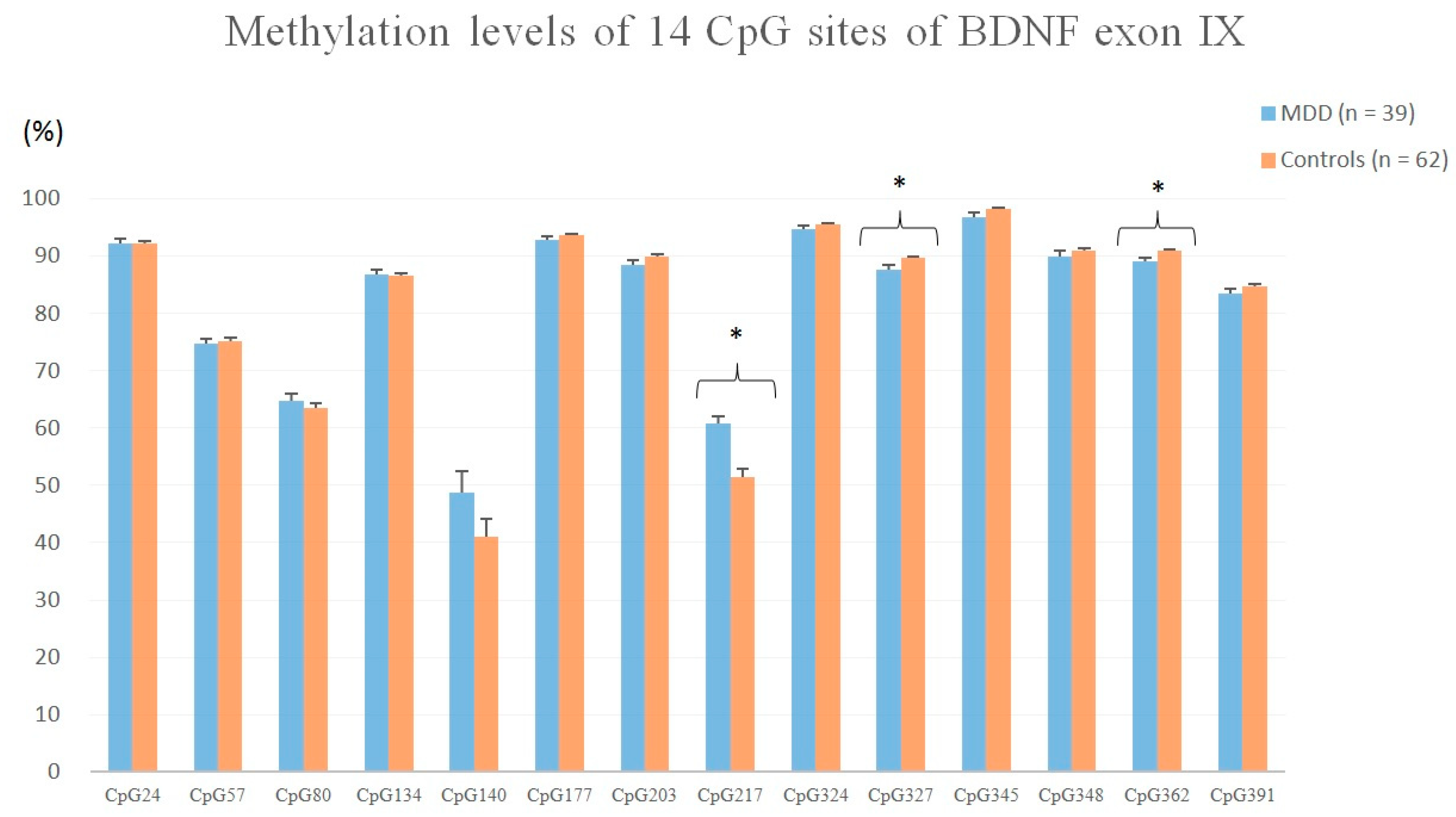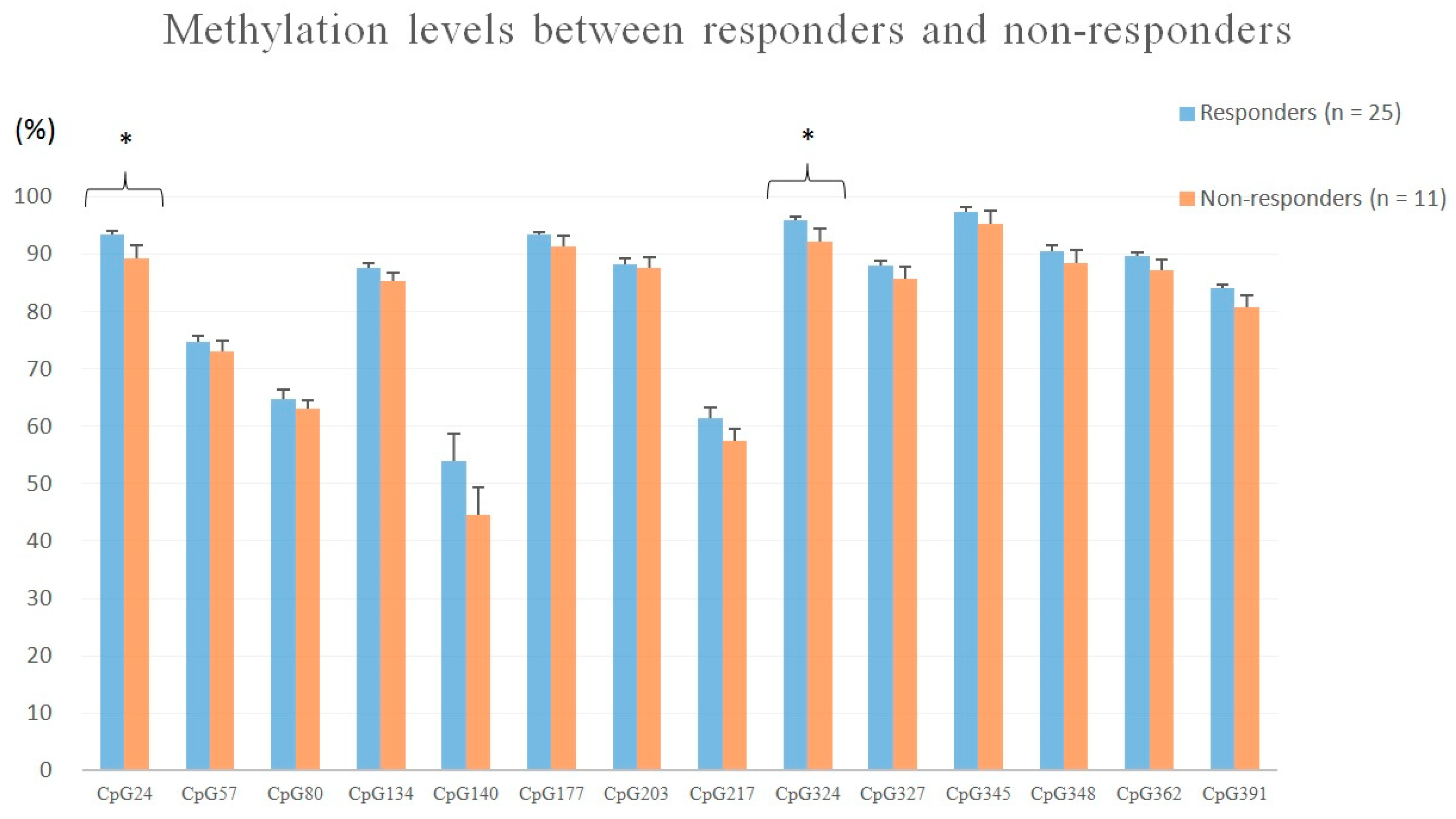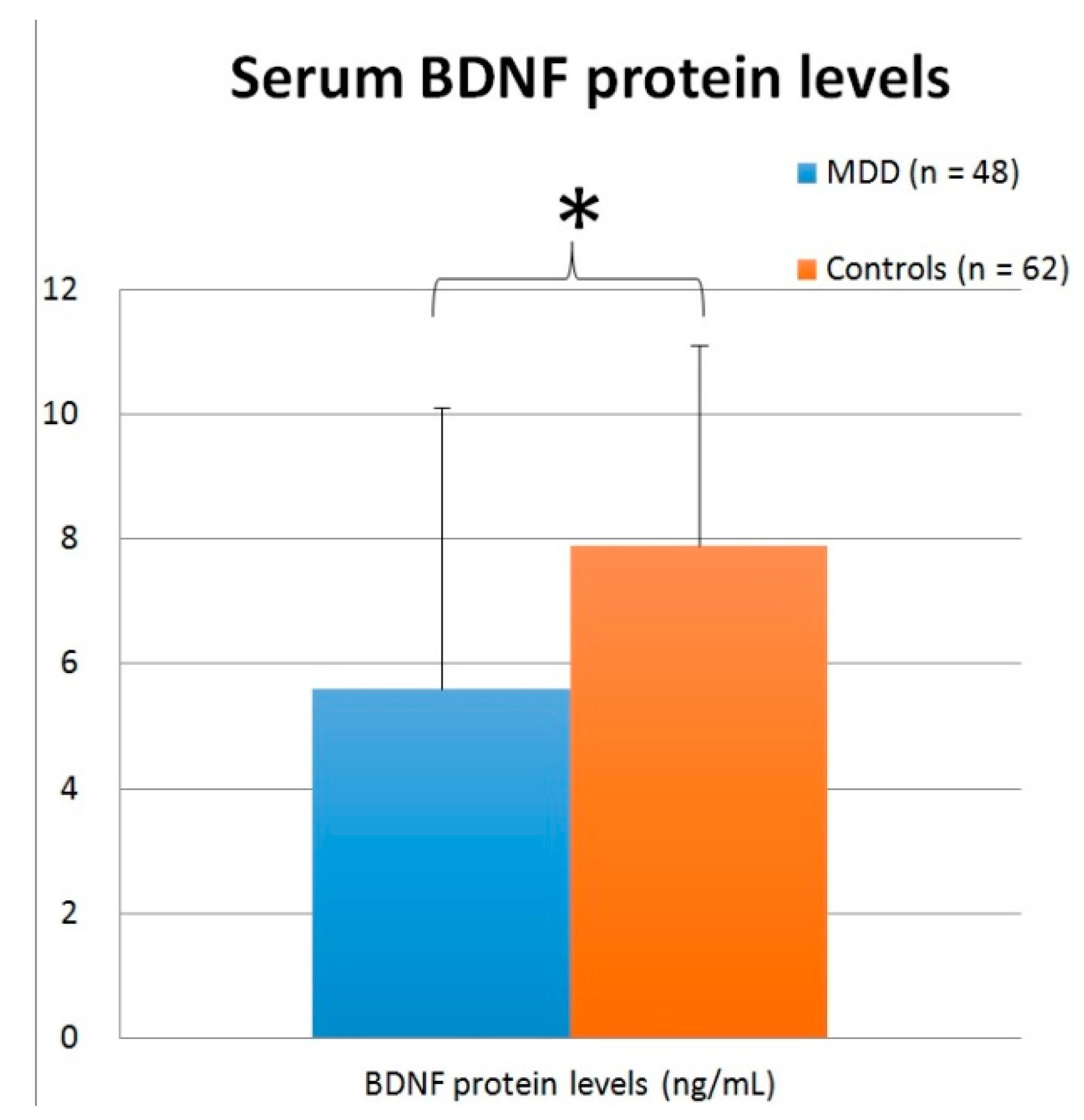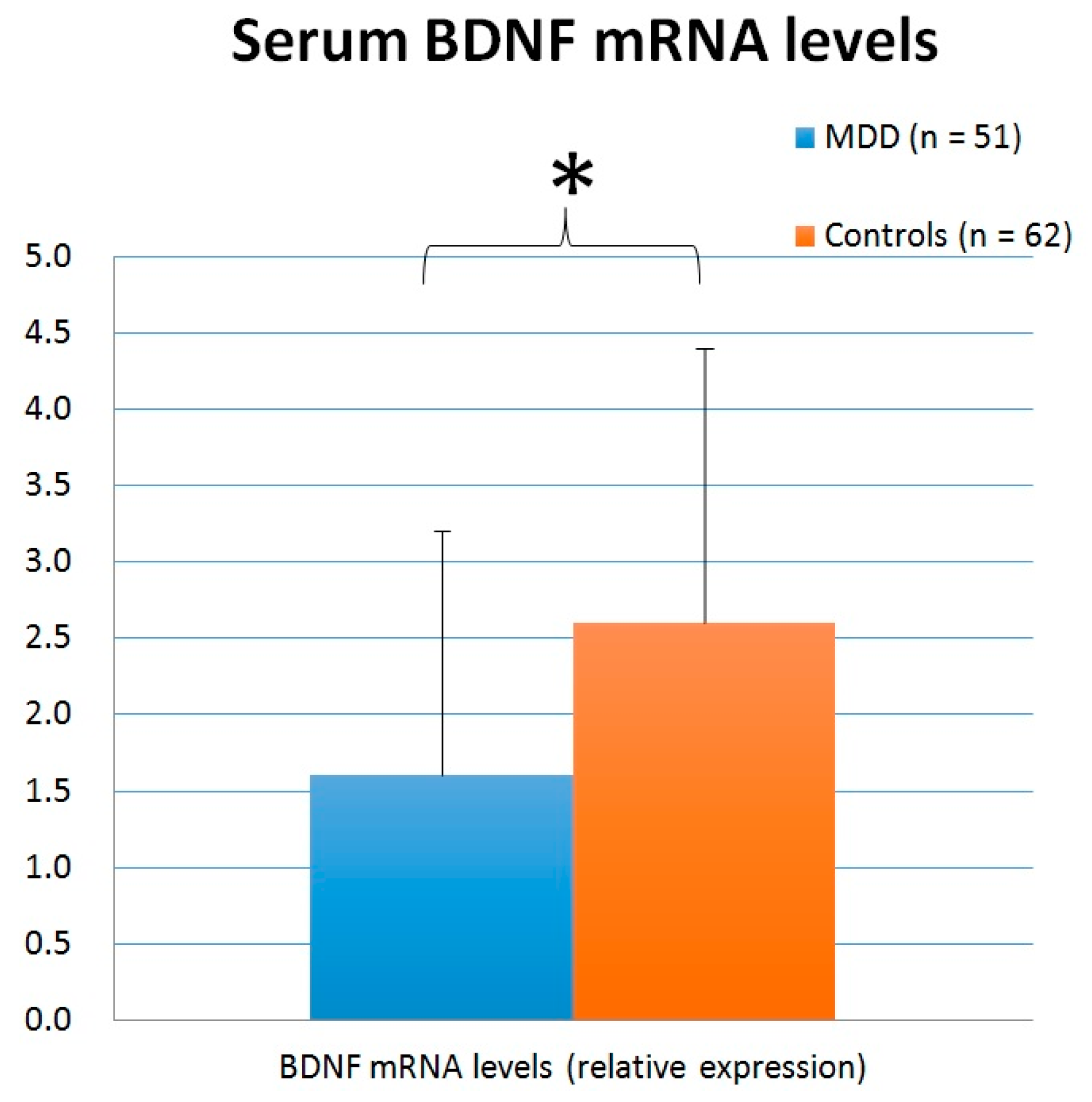Abnormal Brain-Derived Neurotrophic Factor Exon IX Promoter Methylation, Protein, and mRNA Levels in Patients with Major Depressive Disorder
Abstract
:1. Introduction
2. Experimental Section
2.1. Participants
2.2. Assessments of Serum BDNF Protein, mRNA, and DNA Methylation Levels
2.2.1. DNA Isolation and Bisulfite Treatment
2.2.2. Pyrosequencing Analysis
2.2.3. Serum BDNF Protein Levels
2.2.4. mRNA Isolation and Reverse Transcription-Polymerase Chain Reaction
2.3. Data Analysis
3. Results
3.1. Demographic Data
3.2. BDNF Exon IX Promoter Methylation Sequential Analysis
3.3. Serum BDNF Protein Level
3.4. Blood BDNF mRNA
4. Discussion
Author Contributions
Funding
Acknowledgments
Conflicts of Interest
References
- Martinotti, G.; Di Iorio, G.; Marini, S.; Ricci, V.; De Berardis, D.; Di Giannantonio, M. Nerve growth factor and brain-derived neurotrophic factor concentrations in schizophrenia: A review. J. Boil. Regul. Homeost. Agents 2012, 26, 347–356. [Google Scholar]
- Lopes, M.; Fregni, F.; Brunoni, A.R. A systematic review and meta-analysis of clinical studies on major depression and BDNF levels: Implications for the role of neuroplasticity in depression. Int. J. Neuropsychopharmacol. 2008, 11, 1169–1180. [Google Scholar]
- Krishnan, V.; Nestler, E.J. The molecular neurobiology of depression. Nat. Cell Boil. 2008, 455, 894–902. [Google Scholar] [CrossRef] [PubMed] [Green Version]
- Dwivedi, Y. Brain-derived neurotrophic factor: Role in depression and suicide. Neuropsychiatr. Dis. Treat. 2009, 5, 433–449. [Google Scholar] [CrossRef]
- Kang, H.J.; Kim, J.M.; Lee, J.Y.; Kim, S.Y.; Bae, K.Y.; Kim, S.W.; Shin, I.S.; Kim, H.R.; Shin, M.G.; Yoon, J.S. BDNF promoter methylation and suicidal behavior in depressive patients. J. Affect. Disord. 2013, 151, 679–685. [Google Scholar] [CrossRef]
- Duman, R.S.; Heninger, G.R.; Nestler, E.J. A Molecular and Cellular Theory of Depression. Arch. Gen. Psychiatry 1997, 54, 597–606. [Google Scholar] [CrossRef]
- Altar, C.A. Neurotrophins and depression. Trends Pharmacol. Sci. 1999, 20, 59–61. [Google Scholar] [CrossRef]
- Nestler, E.J.; Barrot, M.; DiLeone, R.J.; Eisch, A.J.; Gold, S.J.; Monteggia, L.M. Neurobiology of depression. Neuron 2002, 34, 13–25. [Google Scholar] [CrossRef]
- Dwivedi, Y.; Rizavi, H.S.; Conley, R.R.; Roberts, R.C.; Tamminga, C.A.; Pandey, G.N. Altered Gene Expression of Brain-Derived Neurotrophic Factor and Receptor Tyrosine Kinase B in Postmortem Brain of Suicide Subjects. Arch. Gen. Psychiatry 2003, 60, 804. [Google Scholar] [CrossRef] [PubMed] [Green Version]
- Gonul, A.S.; Akdeniz, F.; Taneli, F.; Donat, O.; Eker, C.; Vahip, S. Effect of treatment on serum brain–derived neurotrophic factor levels in depressed patients. Eur. Arch. Psychiatry Clin. Neurosci. 2005, 255, 381–386. [Google Scholar] [CrossRef]
- Huang, T.-L.; Lee, C.-T.; Liu, Y.-L. Serum brain-derived neurotrophic factor levels in patients with major depression: Effects of antidepressants. J. Psychiatr. 2008, 42, 521–525. [Google Scholar] [CrossRef] [PubMed]
- Karege, F.; Bondolfi, G.; Gervasoni, N.; Schwald, M.; Aubry, J.-M.; Bertschy, G. Low Brain-Derived Neurotrophic Factor (BDNF) levels in serum of depressed patients probably results from lowered platelet BDNF release unrelated to platelet reactivity. Boil. Psychiatry 2005, 57, 1068–1072. [Google Scholar] [CrossRef]
- Martinotti, G.; Pettorruso, M.; De Berardis, D.; Varasano, P.A.; Pressanti, G.L.; De Remigis, V.; Valchera, A.; Ricci, V.; Di Nicola, M.; Janiri, L.; et al. Agomelatine Increases BDNF Serum Levels in Depressed Patients in Correlation with the Improvement of Depressive Symptoms. Int. J. Neuropsychopharmacol. 2016, 19. [Google Scholar] [CrossRef] [Green Version]
- Ernst, C.; Deleva, V.; Deng, X.; Sequeira, A.; Pomarenski, A.; Klempan, T.; Ernst, N.; Quirion, R.; Gratton, A.; Szyf, M.; et al. Alternative Splicing, Methylation State, and Expression Profile of Tropomyosin-Related Kinase B in the Frontal Cortex of Suicide Completers. Arch. Gen. Psychiatry 2009, 66, 22. [Google Scholar] [CrossRef] [PubMed] [Green Version]
- Gau, Y.T.; Liou, Y.J.; Yu, Y.W.; Chen, T.J.; Lin, M.W.; Tsai, S.J.; Hong, C.J. Evidence for association between genetic variants of p75 neurotrophin receptor (p75NTR) gene and antidepressant treatment response in Chinese major depressive disorder. Am. J. Med. Genet. Part B Neuropsychiatric Genet. 2008, 147b, 594–599. [Google Scholar] [CrossRef]
- Gratacos, M.; Soria, V.; Urretavizcaya, M.; Gonzalez, J.R.; Crespo, J.M.; Bayes, M.; de Cid, R.; Menchon, J.M.; Vallejo, J.; Estivill, X. A brain-derived neurotrophic factor (BDNF) haplotype is associated with antidepressant treatment outcome in mood disorders. Pharmacogenom. J. 2008, 8, 101–112. [Google Scholar] [CrossRef]
- Huo, S.-J.; Yen, F.-C.; Tung, C.-L.; Pan, G.-M.; Hong, C.-J.; Tsai, S.-J. Association Study of a Brain-Derived Neurotrophic-Factor Genetic Polymorphism and Mood Disorders, Age of Onset and Suicidal Behavior. Neuropsychobiology 2003, 48, 186–189. [Google Scholar]
- Kaufman, J.; Yang, B.-Z.; Douglas-Palumberi, H.; Grasso, D.; Lipschitz, D.; Houshyar, S.; Krystal, J.H.; Gelernter, J. Brain-Derived Neurotrophic Factor–5-HTTLPR Gene Interactions and Environmental Modifiers of Depression in Children. Boil. Psychiatry 2006, 59, 673–680. [Google Scholar] [CrossRef]
- Licinio, J.; Dong, C.; Wong, M.-L. Novel sequence variations in the brain-derived neurotrophic factor gene and association with major depression and antidepressant treatment response. Arch. Gen. Psychiatry 2009, 66, 488–497. [Google Scholar] [CrossRef]
- Schumacher, J.; Jamra, R.A.; Becker, T.; Ohlraun, S.; Klopp, N.; Binder, E.B.; Schulze, T.G.; Deschner, M.; Schmäl, C.; Höfels, S.; et al. Evidence for a Relationship Between Genetic Variants at the Brain-Derived Neurotrophic Factor (BDNF) Locus and Major Depression. Boil. Psychiatry 2005, 58, 307–314. [Google Scholar] [CrossRef]
- Tsai, S.J.; Cheng, C.Y.; Yu, Y.W.; Chen, T.J.; Hong, C.J. Association study of a brain-derived neurotrophic-factor genetic polymorphism and major depressive disorders, symptomatology, and antidepressant response. Am. J. Med. Genet. Part B Neuropsychiatric Genet. 2003, 123B, 19–22. [Google Scholar] [CrossRef]
- Tsai, S.-J.; Hong, C.-J.; Liou, Y.-J. Brain-derived neurotrophic factor and antidepressant action: Another piece of evidence from pharmacogenetics. Pharmacogenomics 2008, 9, 1353–1358. [Google Scholar] [CrossRef] [PubMed]
- Akbarian, S.; Huang, H.S. Epigenetic regulation in human brain-focus on histone lysine methylation. Biol. Psychiatry 2009, 65, 198–203. [Google Scholar] [CrossRef] [PubMed]
- Fuchikami, M.; Morinobu, S.; Segawa, M.; Okamoto, Y.; Yamawaki, S.; Ozaki, N.; Inoue, T.; Kusumi, I.; Koyama, T.; Tsuchiyama, K.; et al. DNA methylation profiles of the brain-derived neurotrophic factor (BDNF) gene as a potent diagnostic biomarker in major depression. PloS ONE 2011, 6, e23881. [Google Scholar] [CrossRef] [PubMed]
- Mellios, N.; Huang, H.-S.; Baker, S.P.; Galdzicka, M.; Ginns, E.; Akbarian, S. Molecular Determinants of Dysregulated GABAergic Gene Expression in the Prefrontal Cortex of Subjects with Schizophrenia. Boil. Psychiatry 2009, 65, 1006–1014. [Google Scholar] [CrossRef] [PubMed]
- Mill, J.; Tang, T.; Kaminsky, Z.; Khare, T.; Yazdanpanah, S.; Bouchard, L.; Jia, P.; Assadzadeh, A.; Flanagan, J.; Schumacher, A.; et al. Epigenomic Profiling Reveals DNA-Methylation Changes Associated with Major Psychosis. Am. J. Hum. Genet. 2008, 82, 696–711. [Google Scholar] [CrossRef] [Green Version]
- Sweatt, J.D. Experience-dependent epigenetic modifications in the central nervous system. Biol. Psychiatry 2009, 65, 191–197. [Google Scholar] [CrossRef]
- Frieling, H.; Lieb, K.; Bleich, S.; Kotsiari, A.; Tadic, A.P. 1.a.026 Methylation of the promoter of brain-derived neurotrophic factor exon IV and antidepressant response in major depression. Eur. Neuropsychopharmacol. 2014, 24, S169. [Google Scholar] [CrossRef]
- Berton, O. Essential Role of BDNF in the Mesolimbic Dopamine Pathway in Social Defeat Stress. Science 2006, 311, 864–868. [Google Scholar] [CrossRef] [PubMed]
- Roth, T.L.; Lubin, F.D.; Funk, A.J.; Sweatt, J.D. Lasting epigenetic influence of early-life adversity on the bdnf gene. Boil. Psychiatry 2009, 65, 760–769. [Google Scholar] [CrossRef] [PubMed]
- Tsankova, N.; Renthal, W.; Kumar, A.; Nestler, E.J. Epigenetic regulation in psychiatric disorders. Nat. Rev. Neurosci. 2007, 8, 355–367. [Google Scholar] [CrossRef]
- Tsankova, N.M.; Berton, O.; Renthal, W.; Kumar, A.; Neve, R.L.; Nestler, E.J. Sustained hippocampal chromatin regulation in a mouse model of depression and antidepressant action. Nat. Neurosci. 2006, 9, 519–525. [Google Scholar] [CrossRef]
- Keller, S.; Sarchiapone, M.; Zarrilli, F.; Tomaiuolo, R.; Carli, V.; Angrisano, T.; Videtic, A.; Amato, F.; Pero, R.; Di Giannantonio, M.; et al. TrkB gene expression and DNA methylation state in Wernicke area does not associate with suicidal behavior. J. Affect. Disord. 2011, 135, 400–404. [Google Scholar] [CrossRef]
- Ikegame, T.; Bundo, M.; Murata, Y.; Kasai, K.; Kato, T.; Iwamoto, K. DNA methylation of the BDNF gene and its relevance to psychiatric disorders. J. Hum. Genet. 2013, 58, 434–438. [Google Scholar] [CrossRef]
- Roth, T.L.; Lubin, F.D.; Sodhi, M.; Kleinman, J.E. Epigenetic mechanisms in schizophrenia. Biochim. Biophys. Acta 2009, 1790, 869–877. [Google Scholar] [CrossRef] [Green Version]
- D’Addario, C.; Dell’Osso, B.; Palazzo, M.C.; Benatti, B.; Lietti, L.; Cattaneo, E.; Galimberti, D.; Fenoglio, C.; Cortini, F.; Scarpini, E.; et al. Selective DNA Methylation of BDNF Promoter in Bipolar Disorder: Differences Among Patients with BDI and BDII. Neuropsychopharmacol 2012, 37, 1647–1655. [Google Scholar] [CrossRef] [PubMed] [Green Version]
- Keller, S.; Sarchiapone, M.; Zarrilli, F.; Videtic, A.; Ferraro, A.; Carli, V.; Sacchetti, S.; Lembo, F.; Angiolillo, A.; Jovanović, N.; et al. Increased BDNF Promoter Methylation in the Wernicke Area of Suicide Subjects. Arch. Gen. Psychiatry 2010, 67, 258–267. [Google Scholar] [CrossRef] [Green Version]
- Pruunsild, P.; Kazantseva, A.; Aid, T.; Palm, K.; Timmusk, T.; Kazantseva1, A. Dissecting the human BDNF locus: Bidirectional transcription, complex splicing, and multiple promoters. Genomics 2007, 90, 397–406. [Google Scholar] [CrossRef]
- Chong, M.-Y.; Wilkinson, G. Validation of 30- and 12-item versions of the Chinese Health Questionnaire (CHQ) in patients admitted for general health screening. Psychol. Med. 1989, 19, 495. [Google Scholar] [CrossRef]
- Hamilton, M. Development of a Rating Scale for Primary Depressive Illness. Br. J. Soc. Clin. Psychol. 1967, 6, 278–296. [Google Scholar] [CrossRef]
- Bibikova, M.; Lin, Z.; Zhou, L.; Chudin, E.; Garcia, E.W.; Wu, B.; Doucet, D.; Wang, Y.; Vollmer, E.; Goldmann, T.; et al. High-throughput DNA methylation profiling using universal bead arrays. Genome Res. 2006, 16, 383–393. [Google Scholar] [CrossRef] [PubMed]
- Tai, K.-Y.; Shiah, S.-G.; Shieh, Y.-S.; Kao, Y.-R.; Chi, C.-Y.; Huang, E.; Lee, H.-S.; Chang, L.-C.; Yang, P.-C.; Wu, C.-W. DNA methylation and histone modification regulate silencing of epithelial cell adhesion molecule for tumor invasion and progression. Oncogene 2007, 26, 3989–3997. [Google Scholar] [CrossRef] [Green Version]
- Lin, C.C.; Hung, Y.Y.; Huang, T.L. Associations between DNA methylation of Promoter Exon IX, Serum Protein and mRNA levels of Brain-derived Neurotrophic factor in Patients with Bipolar Mania. Neuropsychiatry 2018, 8, 224–231. [Google Scholar]
- D’Addario, C.; Dell’Osso, B.; Galimberti, D.; Palazzo, M.C.; Benatti, B.; Di Francesco, A.; Scarpini, E.; Altamura, A.C.; Maccarrone, M. Epigenetic Modulation of BDNF Gene in Patients with Major Depressive Disorder. Boil. Psychiatry 2013, 73, e6–e7. [Google Scholar] [CrossRef] [PubMed]
- Carlberg, L.; Scheibelreiter, J.; Hassler, M.R.; Schloegelhofer, M.; Schmoeger, M.; Ludwig, B.; Kasper, S.; Aschauer, H.; Egger, G.; Schosser, A. Brain-derived neurotrophic factor (BDNF)—Epigenetic regulation in unipolar and bipolar affective disorder. J. Affect. Disord. 2014, 168, 399–406. [Google Scholar] [CrossRef]
- Dell, B.; Palazzo, M.C.; Benatti, B.; Camuri, G.; Galimberti, D.; Fenoglio, C.; Scarpini, E.; Di Francesco, A.; Maccarrone, M. Epigenetic modulation of BDNF gene: Differences in DNA methylation between unipolar and bipolar patients. J. Affect. Disord. 2014, 166, 330–333. [Google Scholar] [CrossRef]
- Januar, V.; Ancelin, M.-L.; Ritchie, K.; Saffery, R.; Ryan, J. BDNF promoter methylation and genetic variation in late-life depression. Transl. Psychiatry 2015, 5, e619. [Google Scholar] [CrossRef] [PubMed]
- Kim, J.-M.; Stewart, R.; Kang, H.-J.; Kim, S.-Y.; Kim, S.-W.; Shin, I.-S.; Park, M.-S.; Kim, H.-R.; Shin, M.-G.; Cho, K.-H.; et al. A longitudinal study of BDNF promoter methylation and genotype with poststroke depression. J. Affect. Disord. 2013, 149, 93–99. [Google Scholar] [CrossRef] [PubMed]
- Kang, H.-J.; Kim, J.-M.; Kim, S.-Y.; Kim, S.-W.; Shin, I.-S.; Kim, H.-R.; Park, M.-H.; Shin, M.-G.; Yoon, J.-H.; Yoon, J.-S. A Longitudinal Study of BDNF Promoter Methylation and Depression in Breast Cancer. Psychiatry Investig. 2015, 12, 523–531. [Google Scholar] [Green Version]
- Kang, H.-J.; Kim, J.-M.; Bae, K.-Y.; Kim, S.-W.; Shin, I.-S.; Kim, H.-R.; Shin, M.-G.; Yoon, J.-S. Longitudinal associations between BDNF promoter methylation and late-life depression. Neurobiol. Aging 2015, 36, 1764.e1–1764.e7. [Google Scholar] [CrossRef]
- Kim, J.-M.; Stewart, R.; Kang, H.-J.; Bae, K.-Y.; Kim, S.-W.; Shin, I.-S.; Hong, Y.J.; Ahn, Y.; Jeong, M.H.; Yoon, J.-S. BDNF methylation and depressive disorder in acute coronary syndrome: The K-DEPACS and EsDEPACS studies. Psychoneuroendocrinology 2015, 62, 159–165. [Google Scholar] [CrossRef]
- Choi, S.; Han, K.-M.; Won, E.; Yoon, B.-J.; Lee, M.-S.; Ham, B.-J. Association of brain-derived neurotrophic factor DNA methylation and reduced white matter integrity in the anterior corona radiata in major depression. J. Affect. Disord. 2015, 172, 74–80. [Google Scholar] [CrossRef] [PubMed]
- Na, K.-S.; Won, E.; Kang, J.; Chang, H.S.; Yoon, H.-K.; Tae, W.S.; Kim, Y.-K.; Lee, M.-S.; Joe, S.-H.; Kim, H.; et al. Brain-derived neurotrophic factor promoter methylation and cortical thickness in recurrent major depressive disorder. Sci. Rep. 2016, 6, 21089. [Google Scholar] [CrossRef] [PubMed] [Green Version]
- Chagnon, Y.C.; Potvin, O.; Hudon, C.; Préville, M. DNA methylation and single nucleotide variants in the brain-derived neurotrophic factor (BDNF) and oxytocin receptor (OXTR) genes are associated with anxiety/depression in older women. Front. Genet. 2015, 6, 230. [Google Scholar] [CrossRef]
- Li, M.; D’Arcy, C.; Li, X.; Zhang, T.; Joober, R.; Meng, X. What do DNA methylation studies tell us about depression? A systematic review. Transl. Psychiatry 2019, 9, 68. [Google Scholar] [CrossRef]
- Kim, J.-M.; Kang, H.-J.; Bae, K.-Y.; Kim, S.-W.; Shin, I.-S.; Kim, H.-R.; Shin, M.-G.; Yoon, J.-S. Association of BDNF Promoter Methylation and Genotype with Suicidal Ideation in Elderly Koreans. Am. J. Geriatr. Psychiatry 2014, 22, 989–996. [Google Scholar] [CrossRef]
- Lieb, K.; Dreimuller, N.; Wagner, S.; Schlicht, K.; Falter, T.; Neyazi, A.; Muller-Engling, L.; Bleich, S.; Tadic, A.; Frieling, H. BDNF Plasma Levels and BDNF Exon IV Promoter Methylation as Predictors for Antidepressant Treatment Response. Front. Psychiatry 2018, 9, 511. [Google Scholar] [CrossRef]
- Kleimann, A.; Kotsiari, A.; Sperling, W.; Groschl, M.; Heberlein, A.; Kahl, K.G.; Hillemacher, T.; Bleich, S.; Kornhuber, J.; Frieling, H. BDNF serum levels and promoter methylation of BDNF exon I, IV and VI in depressed patients receiving electroconvulsive therapy. J. Neural Transm. (Vienna) 2015, 122, 925–928. [Google Scholar] [CrossRef]
- Lee, B.-H.; Kim, Y.-K. BDNF mRNA expression of peripheral blood mononuclear cells was decreased in depressive patients who had or had not recently attempted suicide. J. Affect. Disord. 2010, 125, 369–373. [Google Scholar] [CrossRef]
- Otsuki, K.; Uchida, S.; Watanuki, T.; Wakabayashi, Y.; Fujimoto, M.; Matsubara, T.; Funato, H.; Watanabe, Y. Altered expression of neurotrophic factors in patients with major depression. J. Psychiatr. 2008, 42, 1145–1153. [Google Scholar] [CrossRef]




| Diagnostic Groups | Age | BMI (kg/m2) | Education (years) | Duration of Illness (years) | Hamilton-17 Item Rating Score | BDNF mRNA Levels |
|---|---|---|---|---|---|---|
| Healthy Controls (n = 62) | 30.2 ± 5.6 | 22.4 ± 4.2 | 17.4 ± 1.8 | 2.6 ± 1.8 | ||
| Men (n = 23) | 27.2 ± 4.1 | 24.2 ± 4.3 | 18.0 ± 3.2 | 2.6 ± 1.4 | ||
| Women (n = 39) | 32.0 ± 5.7 | 21.4 ± 3.9 | 17.2 ± 1.0 | 2.6 ± 2.0 | ||
| MDD (n = 51) | 42.2 ± 11.8 | 22.5 ± 4.4 | 12.2 ± 3.3 | 5.0 ± 5.7 | 33.1 ± 4.9 | 1.6 ± 1.6 |
| Men (n = 16) | 41.3 ± 10.4 | 24.0 ± 5.2 | 12.5 ± 3.2 | 4.9 ± 5.7 | 34.4 ± 3.4 | 0.9 ± 0.5 |
| Women (n = 35) | 42.6 ± 12.5 | 21.9 ± 3.9 | 12.0 ± 3.4 | 5.0 ± 5.8 | 32.5 ± 5.4 | 1.8 ± 1.9 |
© 2019 by the authors. Licensee MDPI, Basel, Switzerland. This article is an open access article distributed under the terms and conditions of the Creative Commons Attribution (CC BY) license (http://creativecommons.org/licenses/by/4.0/).
Share and Cite
Hsieh, M.-T.; Lin, C.-C.; Lee, C.-T.; Huang, T.-L. Abnormal Brain-Derived Neurotrophic Factor Exon IX Promoter Methylation, Protein, and mRNA Levels in Patients with Major Depressive Disorder. J. Clin. Med. 2019, 8, 568. https://0-doi-org.brum.beds.ac.uk/10.3390/jcm8050568
Hsieh M-T, Lin C-C, Lee C-T, Huang T-L. Abnormal Brain-Derived Neurotrophic Factor Exon IX Promoter Methylation, Protein, and mRNA Levels in Patients with Major Depressive Disorder. Journal of Clinical Medicine. 2019; 8(5):568. https://0-doi-org.brum.beds.ac.uk/10.3390/jcm8050568
Chicago/Turabian StyleHsieh, Men-Ting, Chin-Chuen Lin, Chien-Te Lee, and Tiao-Lai Huang. 2019. "Abnormal Brain-Derived Neurotrophic Factor Exon IX Promoter Methylation, Protein, and mRNA Levels in Patients with Major Depressive Disorder" Journal of Clinical Medicine 8, no. 5: 568. https://0-doi-org.brum.beds.ac.uk/10.3390/jcm8050568




